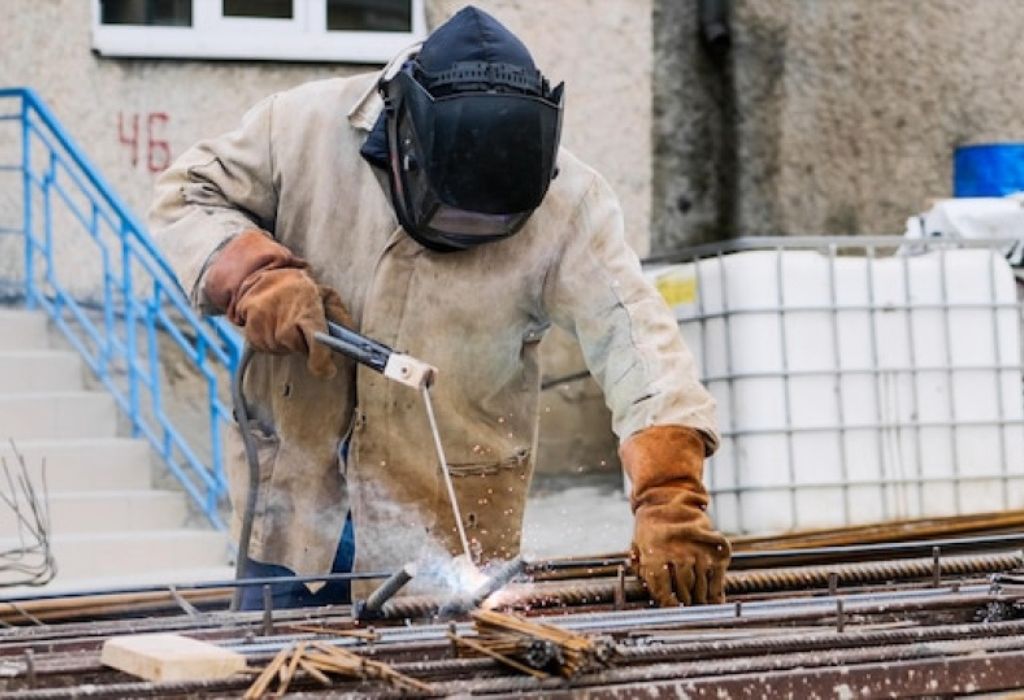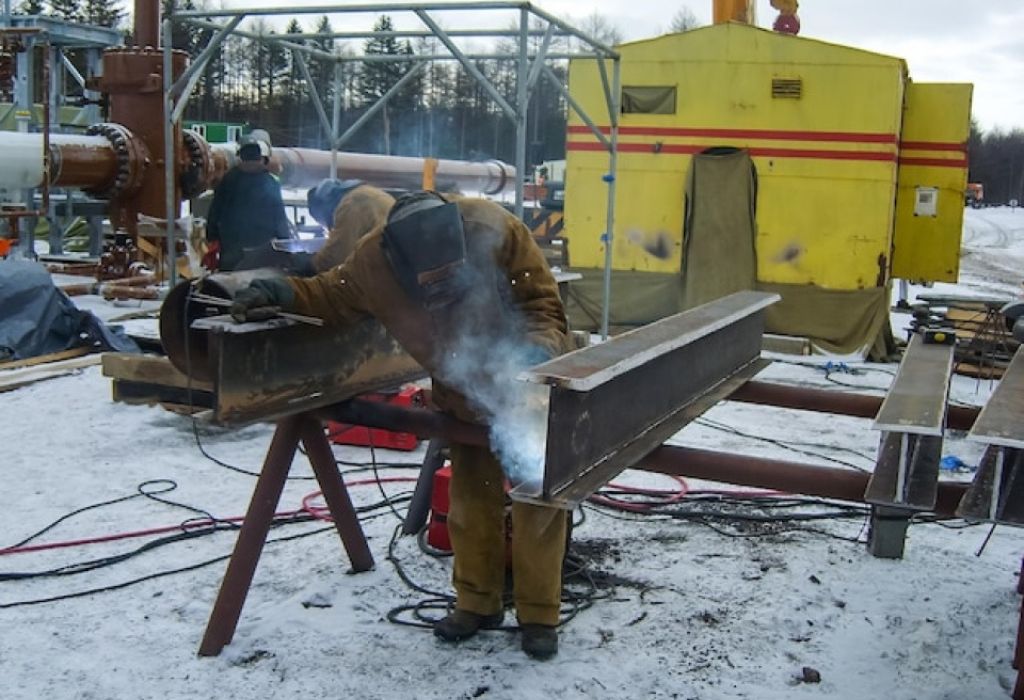The rugged landscapes of Alaska are built on strength, from oil pipelines stretching for miles to ships braving icy seas.
Behind much of this infrastructure are welders whose skills hold everything together.
When people ask how much does a welder make in Alaska, they often expect a straight number.
The truth is more dynamic, shaped by experience, certifications, industries, and even the city where the welder works.
According to the U.S. Bureau of Labor Statistics, the median annual wage for welders nationwide was $48,940 in 2023 (BLS).
In Alaska, the average is often higher due to demand and the challenges of remote work.
Alaska’s economy relies heavily on sectors like oil, gas, construction, and shipbuilding — industries where welders are always in demand.
This creates wage opportunities above the national average.
Many welders in Alaska earn premium pay for travel, overtime, and union contracts. A certified pipeline welder, for instance, may earn nearly double the national median.
Understanding salaries here requires breaking down averages by city, industry, and level of experience.
This guide answers those questions with real data and insights, so welders can see what their skills are worth in Alaska.
Quick Answer: Average Welder Pay in Alaska

On average, welders in Alaska earn between $55,000 and $80,000 per year, depending on skills and location.
Entry-level welders usually start near $25–28 per hour. Skilled and certified professionals can reach $40–50 per hour, especially in pipeline or offshore work.
Remote jobs often add per diem allowances, making overall compensation higher than base hourly rates.
How much does a welder make in Alaska on average?
Between $55,000 and $80,000 annually.
What’s the hourly wage for welders in Alaska?
Most earn $25–40 per hour, with top earners exceeding $50.
Do Alaskan welders earn more than the U.S. average?
Yes, wages are often 15–30% higher.
Are bonuses common?
Yes, travel pay and overtime frequently boost income.
Is pipeline welding the highest paying?
Yes, it often provides the top wage scale in Alaska.
Salary Breakdown by City
Wages differ across Alaska depending on demand and cost of living. Anchorage, Fairbanks, and Juneau lead in job availability.
Anchorage welders average $60,000–$75,000 per year, while Fairbanks welders often work on energy-related projects that push earnings closer to $70,000–$80,000.
Remote regions, where travel and logistics are tougher, may offer higher base pay or per diem benefits.
Which city pays welders the most in Alaska?
Fairbanks and Anchorage are top-paying hubs.
Is Juneau pay lower?
Slightly, but opportunities exist in marine welding.
Do remote jobs pay more?
Yes, they often include per diem allowances.
Are city jobs easier to find?
Yes, Anchorage offers the most consistent demand.
Does cost of living affect pay?
Yes, cities with higher expenses often provide higher wages.
Welding Pay by Industry
Alaska’s major industries determine salary potential. Oil and gas offer some of the highest rates, followed closely by shipbuilding and heavy construction.
Pipeline welders frequently earn premium wages due to strict certification requirements and the harsh environments of the job.
Marine welders in shipyards or offshore projects also command strong pay. Meanwhile, construction and manufacturing welders earn slightly lower but steadier salaries.
Which industry pays welders the most in Alaska?
Oil and gas, especially pipeline welding.
Are marine welders well paid?
Yes, especially for offshore or shipyard projects.
Do construction welders earn less?
Slightly, though union contracts raise pay.
What about manufacturing welders?
They often earn stable but mid-range wages.
Is energy sector welding more demanding?
Yes, requiring specialized training and certifications.
Entry-Level vs. Experienced Welders
Beginners in Alaska may earn $25–28 per hour, often through apprenticeships or helper roles.
As welders gain certifications and field experience, their pay can rise to $35–45 per hour. Those with 10+ years and advanced skills, such as underwater or pipeline welding, can exceed $50 per hour.
Skill, not just time, is the deciding factor in how much does a welder make in Alaska.
What’s the pay for entry-level welders in Alaska?
Around $25–28 per hour.
How quickly can wages increase?
Within 2–3 years with added certifications.
Do senior welders make double?
Yes, top specialists can double entry-level pay.
Does union membership help?
Yes, unions negotiate higher base wages.
Is underwater welding top tier?
Yes, it is among the most lucrative specialties.
Union vs. Non-Union Wages

Union welders in Alaska often earn 10–20% more than non-union peers. Benefits include health coverage, pensions, and overtime protections.
Non-union welders may find more flexible jobs but with fewer benefits. For large energy projects, union membership often becomes a requirement.
Are most Alaskan welders unionized?
Yes, especially in oil, gas, and construction.
Do unions negotiate pay raises?
Yes, regularly through contracts.
What benefits come with unions?
Healthcare, pensions, and stronger job security.
Can non-union welders still earn well?
Yes, especially in smaller or remote projects.
Do unions control hiring in big projects?
Yes, they often supply certified workers for contracts.
Specialized Welding in Alaska
Alaska rewards welders with niche expertise. Underwater welders, pipeline welders, and certified high-pressure welders command the highest pay.
The challenging environments require advanced training, but the rewards often justify the effort. Some specialists exceed $100,000 annually.
Which specialization pays most in Alaska?
Pipeline and underwater welding.
Is extra training required?
Yes, advanced certifications are mandatory.
Do specialized welders travel more?
Yes, often across remote Alaska.
Can specialists earn six figures?
Yes, in demanding roles like pipeline work.
Is specialized gear provided?
Yes, by employers on large projects.
Overtime, Per Diem, and Travel Pay
A big part of Alaskan welder income comes from extras beyond base pay. Overtime is common, especially in seasonal projects.
Per diem allowances cover housing, food, and travel for remote jobs, adding thousands annually to take-home pay.
Travel pay ensures welders working away from home are compensated for time and distance.
Do Alaskan welders work overtime often?
Yes, especially in peak seasons.
What’s per diem pay?
Daily allowances for living costs in remote jobs.
Is travel time paid?
Yes, many contracts include travel pay.
Can per diem boost income?
Yes, by $10,000+ annually.
Is overtime mandatory?
Often, depending on project deadlines.
Job Outlook for Welders in Alaska
Welding remains a vital trade in Alaska. Oil, gas, marine, and construction sectors continue to demand skilled labor.
The BLS projects about 42,600 welding job openings annually across the U.S. (BLS). Alaska, with its infrastructure needs, secures its share of these opportunities.
While automation affects some industries, manual welding in remote and high-pressure environments remains essential.
Is welding demand strong in Alaska?
Yes, due to energy and infrastructure projects.
Are new welders needed?
Yes, as older workers retire.
Will robots replace welders?
Not in remote, custom, or pipeline welding.
Is seasonal work common?
Yes, projects often follow weather cycles.
Can welders move into inspection roles?
Yes, with certifications like CWI.
Skills That Boost Welding Income

Welders who invest in extra skills see faster wage growth. Certifications in AWS, ASME, or underwater welding increase value.
Soft skills matter too. Reliability, teamwork, and endurance help welders secure longer contracts and leadership opportunities.
Which certification pays most?
Pipeline and underwater certifications.
Do soft skills affect pay?
Yes, they impact career stability.
Is AWS certification important?
Yes, it is widely recognized.
Do bilingual welders earn more?
Sometimes, in diverse job sites.
Does safety training raise income?
Yes, safety-certified welders are preferred.
Conclusion
So, how much does a welder make in Alaska? The answer depends on location, industry, and skill, but averages fall between $55,000 and $80,000 per year.
Top welders in pipelines, offshore, and underwater work often cross six figures. Union contracts, overtime, and per diem further boost earnings.
In Alaska’s demanding industries, welders don’t just make a living — they make a strong future, one weld at a time.

I’m Darrell Julian, the founder, lead writer, and hands-on welding enthusiast behind ArcWeldingPro.com. With more than 15 years of real-world welding experience, I created this platform to share what I’ve learned in the field, in the shop, and in the heat of the arc.


